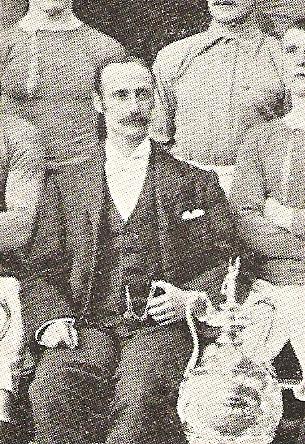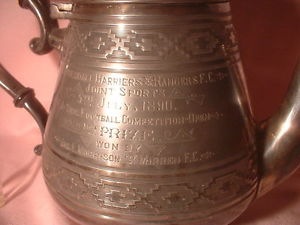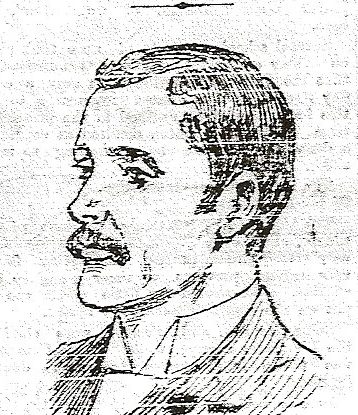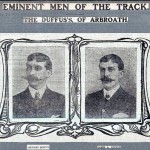The Rangers had been holding sports successfully since their first venture into athletics promotion in 1881. When the Clydesdale Harriers came into being in May 1885, they trained at the Rangers grounds at Kinning Park and Ibrox. The clubs had members in common and they held joint sports for a while. This changed in 1890 when the clubs agreed to hold their separate meetings. The joint ventures had been held at the start of July but from 1890 the Rangers meeting was held on the first Saturday in August: this would be a fixture in the calendar right up into the 1960’s. The Herald commented upon this.
“For a couple of seasons past the Rangers and Clydesdale Harriers combined their meetings. This year however the Rangers courted success independently and met with their reward. Fully 6000 spectators were present at Ibrox Park on Saturday to witness the various events. The weather was all that could be desired, if anything it was too warm for the competitors in the various events, the football especially. The athletes were not numerous but a good day’s sport was witnessed nevertheless. Considerable interest was taken in the football tournament for which four clubs competed – namely Rangers, Dumbarton, St Mirren and Linthouse. [Glasgow Herald, 4th August, 1900]
The absence of the new club, Celtic FC, from the football was maybe explained by the fact that they had a tournament of their on on that day and had three 5-a-side teams competing there. Events contested at Ibrox in 1890 included quarter mile flat handicap confined to football section (J Henderson (30 yards) won by a foot from AH McKenzie off 10 yards; quarter mile flat handicap open won by D Wright Abercorn FC from CL Aitken, Clydesdale H; one mile flat race handicap won by W Henderson from AG Colquhoun, both Clydesdale H; three miles ordinary bicycle race; two mile safety bicycle race. Bicycle races were held at this time on machines with solid tyres, the pneumatic variety just being introduced. Some meetings would hold two races at a particular distance – one for bicycles with solids and the other for Bicycles with pneumatics. On the same day as this report was published in the Herald, the ‘Scottish Referee’ had a letter debating whether the pneumatic tyres should be banned. Among the officials on duty were John Mellish and Tom Vallance as Judges, and Alex Vallance as Time keeper.
Andrew Hannah
In 1891 the Rangers Sports were held on Saturday, August 1st, and as might be expected many of the officials as well as competitors were from Clydesdale Harriers. Many of course had dual membership including John Mellish who would play a significant part in resolving the dispute that split Scottish athletics in 1885/86. Most sports had their special event, or even a novelty event, to draw in the crowds and one of the most popular events at this meeting was a 440 yards race confined to “bona fide playing members of Rangers FC.” It was won by Reid (30 yards) the goalkeeper, from Kerr (35) and AR MacKenzie (10). However the fact that football prevails even at the Rangers Sports was evident right at the start of the report in the ‘Scottish Referee of 3rd August, 1891:
“Long may this flag float over a vigorous club, and may remembrance of victory already achieved stimulate the club to greater exertions in future,” These were the stirring, cheering words that Councillor Primrose spoke after unfurling the Rangers Joint League Championship flag on Saturday. So far as their sports were concerned, the flag was honourably hoisted, and it is to be hoped that similar luck will follow the club so long as a tattered rag of the banner floats gaily in the breeze. One disappointment was experienced by the 10,000 people present, and that of course, was the non-appearance of FJ Osmond the English champion cyclist whose recent phenomenal performances have electrified the wheel world. ,,,,, “
*
The first Saturday in August, 1892 was the 6th of the month and like its predecessors it was a great success. The biggest crowd ever seen, 12,000 spectators, was present at the games and, financially, £259 was taken at the gate, £60 for the stands, and the total with entry fees etc came to over £350. Typical of the period the cycle racing was a big draw with Mecredy, the Irish champion proving to be a crowd pleaser. The ‘Scottish Referee’ commented ‘cycling is booming.’ Beveridge and Tom Blair were the top sprinters but they held the 440 yards confined to Rangers players again and A Mc Creadie who won it was reported to be all out at the finish. There were several close races, especially the 220 yards invitation: “Did McCulloch or McLeod win the 220 invitation? This is still a problem with most people although Judge McNab has it solved to his satisfaction by giving the race to McCulloch, The finish was certainly a close affair, and in the circumstances it might have been as well to have had a couple of judges on the men. McLeod led until ten yards from home, then McCulloch drew level with him, throwing upon his powerful rival that characteristic glance which implies that he has a grip of his man, but which almost lost him the race. On the tape McCulloch should conserve all his attention and leave those “glances” to the finish. The time was given 24 2/5 seconds exactly – the same as McCulloch did in his heat – and yet he did not run so strongly. Three watches were on the event and two of them gave the time as 23 2/5th seconds. If this really be the case then McCulloch has equalled McLeod’s record time for the distance made at the WSH meeting in 1891. ”
With a big crowd, quality athletics on display and a profit at the end of the afternoon, what more did a meeting want?
*
The meeting on 5th August 1893 was a well supported one – 12 heats, semi finals and a final of the 100 yards with Rangers player JR Gow (3 yards) making the final’ ; 8 heats of the 220 with Rangers man H Barr winning his Heat. The ‘Glasgow Herald’ reported as follows.
“Ibrox was the centre of attention on Saturday afternoon, the occasion being the annual sports of the Rangers FC, which were a great success in every respect. The sprints were capitally contested, ; indeed all the races – cycle and flat – resulted in very close finishes. We can only refer to one or two of the outstanding features of the day’s sport. First then TE Messenger created a small sensation by breaking the 600 yards record. He sliced 2-5th off the previous best, and had he been pressed to any extent, he would have done much better time. Messenger ran very smoothly and he displayed perfect skill from start to finish. Another feature of the meeting was the failure of AR Downer, the Scottish champion, from whom great things were expected. He was badly beaten in the 100 yards heat, the time for which was 10 2-5th sec; and in the 220 yards heat he was at least four yards worse than 23 seconds. DR McCulloch’s success appeared to give great satisfaction to all present. He just lost the 100 yards final by a breast after a most spirited finish with J Weir of Milngavie FC (6 yards). JJ Rice (Partick Thistle), 17 yards, had something to spare in the final of the 220 yards handicap. The mile was won in 4 min 28 2-5th off 60 yards which shows that J Stavert is a rapidly improving runner. The Clydesdale Harriers Mile was won in 4 min 23 sec. and Morton did his record 4 min 24 1-5th on the Rangers ground. Hannah did not run quite up to form on Saturday. At one time he looked like winning the two miles handicap, but he cracked badly when the supreme moment came. S Duffus, Arbroath Harriers (20 yards) won and T Mitchell, Paisley Harriers, who might have been first had he not spurted so soon was a good second. The cycling as usual called forth great interest. The gate money yielded over £200.”
At the end of the day’s sport the prizes were presented by Mrs Primrose, wife of Bailie Primrose.
Stewart Duffus and his brother JS
The ‘Glasgow Herald’ had an interesting take on the 1894 meeting when it began “The new professionalism had its beginning at Ibrox Park on Saturday and Rangers FC are to be congratulated on their efforts to popularise cycling in Scotland. Though the number of riders present fell far short of what was expected, still there was a fairly large contingent of what is known as the Paris crowd to make the racing interesting to the 15000 spectators who came there impelled as much by curiosity as much as by desire to see good sport. …” The meeting, which included a four-a-side football competition, seems to have been the only one held on the Saturday with the amateur athletics being held on the following Monday.
This Monday meeting contained many top names as well as several amateur cycle races. The same paper reported on Tuesday, 6th August:
“Following their professional tournament on Saturday, the Rangers last night held a meeting last night open to amateurs only. There was a good attendance of spectators and, considering that the weather was bitterly cold and that there was a strong breeze, the sport was excellent. Indeed the two miles flat race was the finest ever witnessed in Glasgow, and resulted in a very popular win for A Hannah .”
Events at the meeting included 100 yards handicap (10 heats, 2 semi finals, final), 600 yards flat handicap (third in this race was RS Langlands who would become the first Scot to run under two minutes for 880 yards), Two Miles flat plus three cycle races (half mile, one mile and five miles). It was a very short programme compared to the normal Rangers sports and for the athletics supporters being limited to three events on a Monday evening was not what they would have wanted.
It had been an experimental weekend, the least successful meeting for several years but 1895 would see a return to the normal format. However the pace in athletics events for their relative sports was being set, for the time being at least, my Maley of the Celtic who was inviting the top men from all over Britain, maybe especially Ireland, to his club’s meetings.



